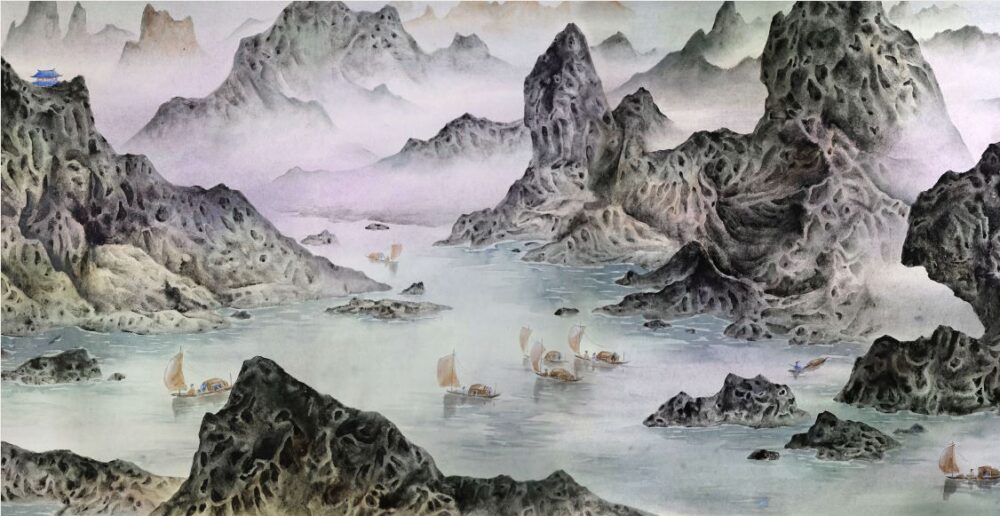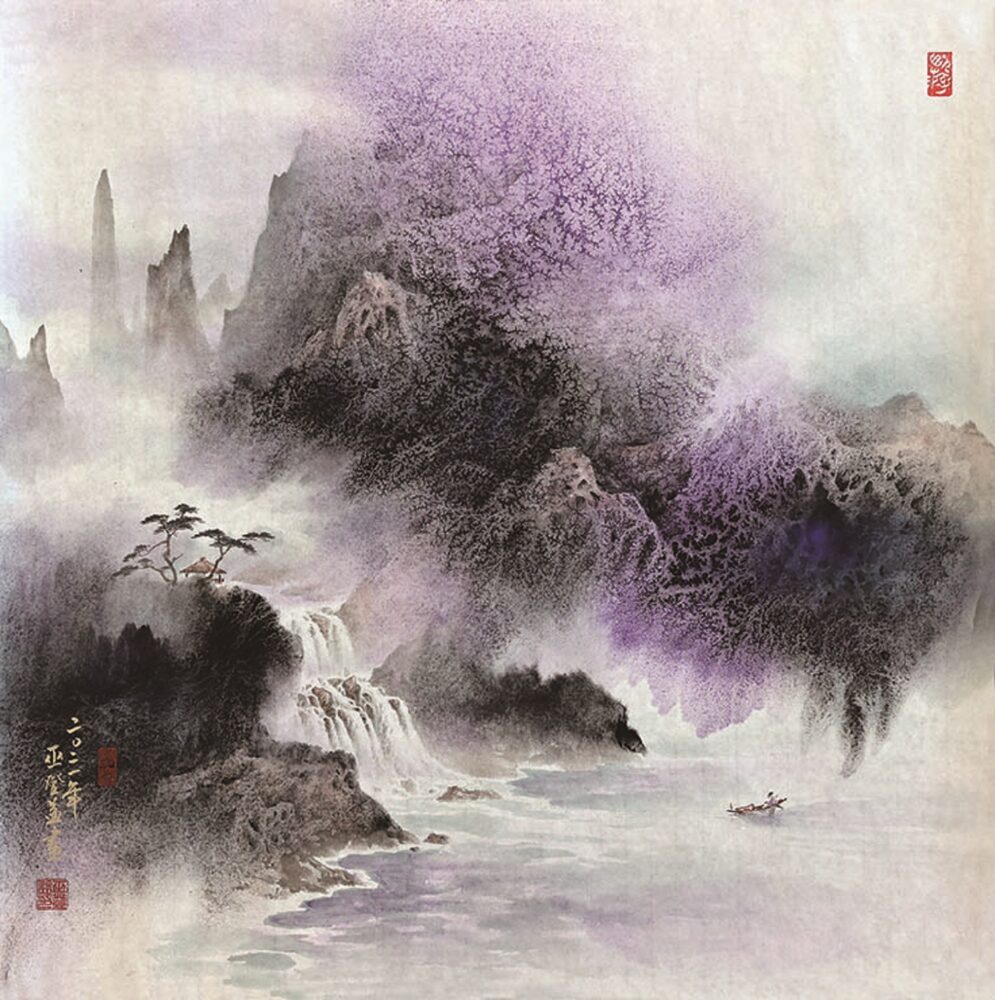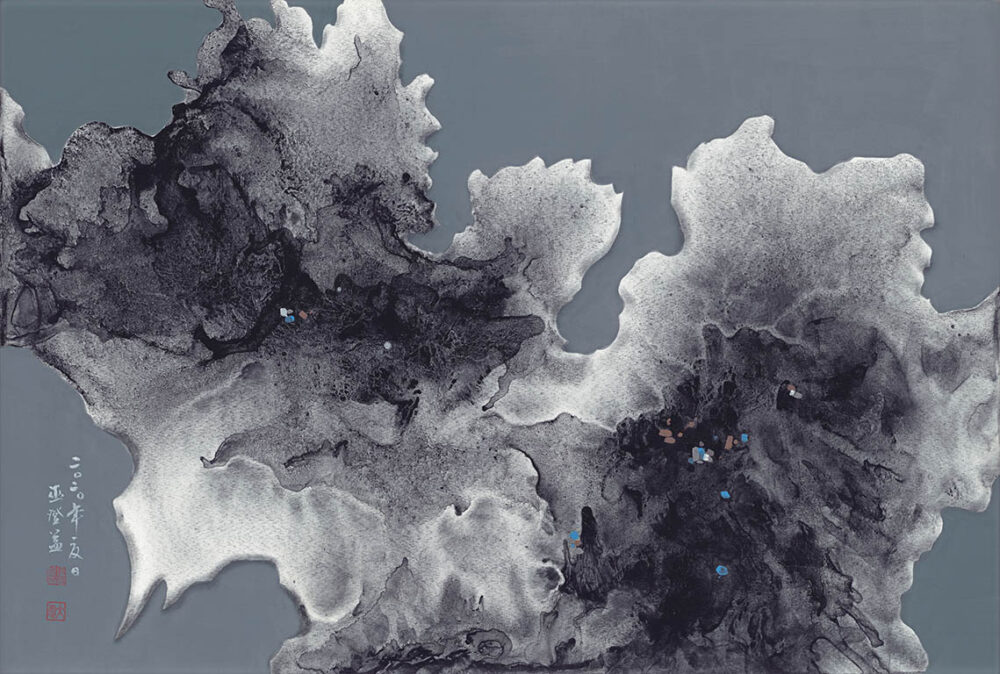No products in the cart.
Art Reviews
From the ambiguity of the sense of ink and wash to the cognitive diversity of color ink-Wu Deng-yi’s contemporary color ink
Chen Chaoxing, vice-chairman of the International Art Critics Association of UNESCO
I have been fascinated by Yu Chengyao for many years, he subverted the context structure of ink painting; I also admire Wu Guanzhong for refining the aesthetic characteristics of Chinese painting and opening up the Chinese aesthetic connotation of abstraction; I love Li Keran and Qi Baishi even more; but I do not forget Dong Qichang, I understand Wang Yuanqi by heart. But when I climbed to the cloud, the “Wu Dengyi Art Museum” on the 32nd floor of Taipei 101 Building, I met Mr. Wu Deng-yi’s works, but I was amazed and speechless for a while. I originally thought it was because I was shallow and left behind a generation of ancient masters, but Mr. Wu is actually a contemporary master from Puli, Taiwan.
Although the landscape of Taiwan’s is relatively cramped and restrained, and the landscape and momentum have always been reserved, Mr. Deng-yi’s creations of large mountains and rivers are natural, and he is humble in the face of nature, and he learns from nature. Since the Yuan Dynasty, Chinese painting aesthetics has emphasized mastering the form and meaning of brush and ink. The so-called “calligraphy into painting” is the product of this tendency to emphasize “meaning” and “reproduction” in addition to “writing form”. However, Wu Deng-yi did not completely operate in the place of brush and ink. He jumped out of the pattern of literati painting, so he used color to escape the real and dreamlike charm of literati
painting, and used repeated up and down, left and right stacked mountains to construct the perspective and the juxtaposition of the east and the west. The psychological layout of “mindscape” carefully uses the height, distance, depth, light and shade, and even high contrast of the scene to create a picture full of changes and rhythm. He uses contrast methods (such as high contrast and multiple colors), pulls the entwined mountains away from the hints of space and the tension of the moving line. The winding path is deep and intricate, the distance can be borrowed into a close-up view, the layers can be separated but not separated, and the layers can be separated but not separated. There are also layers of echoing composition, forming a unique Wu Deng-yi color ink style.

Imperial Landscapes (Detail) 65.6X1588cm 2021 Ink & Color on Paper
On the one hand, Mr. Wu Deng-yi mastered the physical principles and essence of the figurative realism of traditional painting, and entered the ultimate micro-state. On the overall appearance, he used the imagination space of abstract freehand and adopted innovative techniques to inject the spirituality of abstract expression in color and composition, so as to achieve the goal of creating a new artistic conception. Give the work a sense of the times and contemporary. The special media and diverse techniques produce various changes in the works, forming a rich and natural texture with varying shades, as vivid as the water surface is moving and still. Replacing the traces carved with the pen with natural effects, Mr. Wu’s color and ink works show a natural aura, which can be said to be a natural and integrated one, just like Liu Zongyuan’s “Xishan Banquet Travel Notes” when he climbed to the top but still full of natural humility.

Splendor 66 X 66cm 2021 Ink & Color on Paper
If what traditional brush and ink pursues is the integrity of various “forms and meanings”, then Mr. Wu’s brushes and inks try to find a new way, and go the opposite way to “form out of impossibility”. “After deliberately escaping the paddock of brush and ink, Mr. Wu Deng-yi’s paintings, whether landscape, figures, bright moon, dead trees, and owls, all create contemporary themes and reflections. Especially in the creation of landscapes of the earth, such as the huge long scroll《Imperial Landscapes》exhibited for the first time at the “Art Taipei” this year, Mr. Wu has achieved his important goal in his works with majestic momentum, which is to present a complex and rich “landscape”. The most amazing thing about this sense of layering is that in his paintings, the structure creates new physical relationships, resulting in a variety of superimposed rocks that are “imaged”, and their overlapping outlines endow the landscape with a clarity The “sense of life intertwined between the virtual and the real” that cannot be imagined by the physical image, the Xumi mustard seeds that see through the physical image, the real is empty, and the virtual is real. Can “smile”. The painting is like a wind, the painting is like a flag, it is intended to be heart-warming, not in the painting, but in the painting. Mr. Wu’s works seem to be objects, but in fact there are many contemporary expressions between realism and abstraction.

Vague in Shade, The Awareness in Mind 61 X 90cm 2020 Ink & Color on Paper
Aesthetics is constantly shifting and undergoing paradigm shifting, and a pattern of aesthetic standard transformation is found in the transformation of the appearance of color and ink. From the traditional Chinese paintings of the Sui, Tang, and Five Dynasties to the Northern Song Dynasty, to the traditional literati paintings of the Southern Song and Yuan dynasties, to the late Qing and early Republic of China paintings by Huang Binhong (1865-1955) and Qi Baishi (1864-1957) In fact, Lin Fengmian (1900-1991) and Li Keran (1907-1989) have actually changed dramatically from the previous period. Must the definition of contemporary ink painting be re-clarified and confirmed? What is its position in art history and what is its expressed appeal? These are related to the depth and grandeur of contemporary ink painting, and we have seen Mr. Wu Deng-yi set a new model in the creation of contemporary ink painting.
